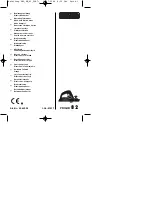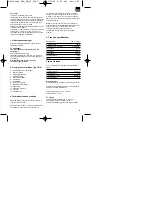
5. Before starting the equipment
Before you connect the equipment to the mains
supply make sure that the data on the rating plate
are identical to the mains data.
Always pull the power plug before making
adjustments to the equipment.
5.1 Adjusting the chip depth (Fig. 4)
You can adjust the chip depth in steps of 0.2 mm
from 0 to 2 mm by turning the setting knob for the
chip depth (1).
Turn the setting knob for the chip depth (1) in a
clockwise direction to set a greater chip depth.
Turn the setting knob for the chip depth (1) in a
counter-clockwise direction to set a lower chip depth.
After finishing work, set the chip depth so that the
blades are lowered and thus protected from damage.
Turn the setting knob for the chip depth to position
“P” for this purpose.
5.2 Dust extraction (Fig. 5)
For an optimal dust extraction you can fit the dust
bag (12) supplied. To do so, slide the dust bag (12)
into the dust outlet (10) on the side of the electric
hand plane.
Secure the dust bag by turning it.
The dust bag (12) can be connected to the chip
ejector (10) optionally on either the left or right. Use
the changeover switch (9) to select between the chip
ejectors (10).
5.3 Parallel stop (Fig. 6)
Use the parallel stop (13) when you want to plane
parallel to the edge of the workpiece.
Installing the parallel stop:
Fasten the mount (d) of the parallel stop to the
left side of the tool using the supplied thumb
screw (a).
Now connect the mount (d) to the slide of the
parallel stop (13).
The guide rail must always be aligned in
downward direction.
Fix the distance required between the parallel
stop and the edge of the workpiece.
Fasten the parts with the carriage bolt (b) and
the wing nut (c).
6. Operation
6.1 ON/OFF switch (Fig. 7)
The hand-held electric plane comes with a safety
switch which is designed to prevent accidents.
To switch on the tool press the side safety lock-
off (3) and press the button switch (4). The safety
lock-off (3) can be pressed from the left and
right.
Release the button switch (4) to switch off the
electric plane. The button switch (4) jumps back
into its starting position.
6.2 USING THE MACHINE
Important:
The electric hand-held plane must be
switched on before coming into contact with the
workpiece.
6.2.1 Planing flat surfaces
Set the desired planing depth. Place the front
baseplate of the electric hand-held plane on the
workpiece and switch it on. Holding the plane in both
hands, slide it over the surface, making sure both the
front and rear baseplates are lying flat on the
workpiece.
To finish the planed surface, set a very low planing
depth and rework the planed surface as often as
necessary.
6.2.2 Chamfering edges (Fig. 8-9)
The fast and simple chamfering of edges at an angle
of 45° is made possible by the V groove (a)
integrated in the front base plate (8).
Place the plane with the V groove on the edge you
wish to machine and move it along it, ensuring that
you move it at an even speed and maintain a
constant angle.
6.2.3 Planing steps (Figs. 6, 10)
The planing of steps is possible with the help of
the parallel stop (13).
Mount the parallel stop (13) on the left side of the
tool (see section 5.3).
Release the locking lever (a) and position the
step depth scale (11) so that the required step
depth is displayed. Tighten the locking lever (a)
again.
Width of step:
You can set the width of the step with the parallel
stop (13).
10
GB
Anleitung PRO_HB_82_SPK7:_ 23.07.2008 8:39 Uhr Seite 10
Содержание 43.452.90
Страница 2: ...2 1 2 1 10 10 2 3 4 5 9 3 12 13 7 8 11 6 Anleitung PRO_HB_82_SPK7 _ 23 07 2008 8 39 Uhr Seite 2...
Страница 3: ...3 4 5 6 7 8 9 1 d c b 9 a 3 4 8 a 13 10 10 12 Anleitung PRO_HB_82_SPK7 _ 23 07 2008 8 39 Uhr Seite 3...
Страница 4: ...4 10 11 12 a 11 a 6 14 15 6 13 7 a d b c Anleitung PRO_HB_82_SPK7 _ 23 07 2008 8 39 Uhr Seite 4...











































